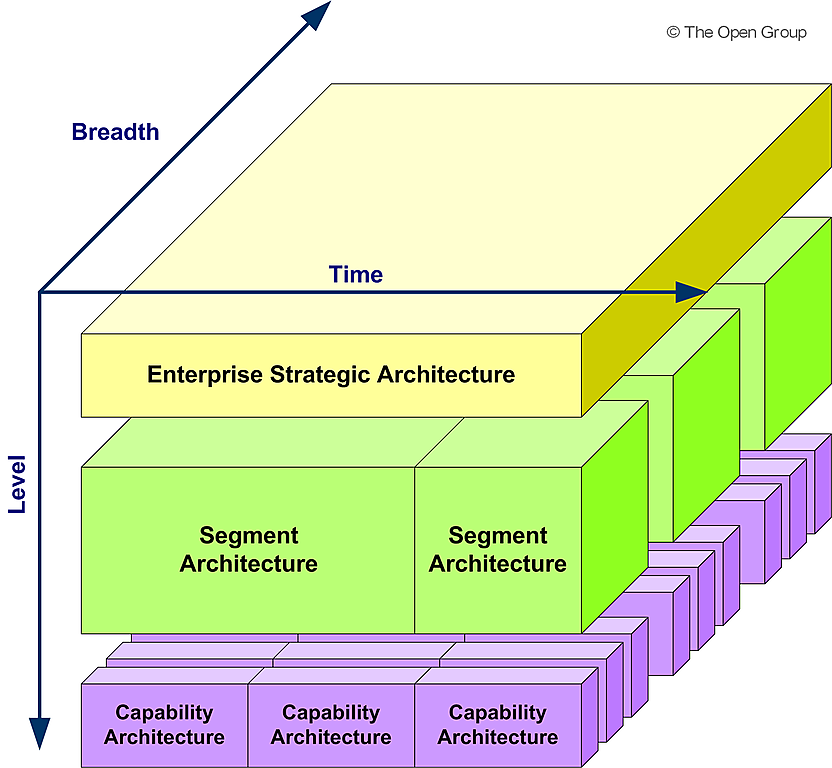Understanding the TOGAF EA Landscape
Overview
In the realm of Enterprise Architecture (EA), the TOGAF (The Open Group Architecture Framework) EA Landscape serves as a conceptual framework that organizes the various architectures present within an enterprise. Given the complexity and diversity of architectural needs in an organization, it is essential to structure these architectures effectively. The TOGAF standard employs the concepts of levels and the Enterprise Continuum to provide clarity and organization within the Architecture Landscape.
Complexity of the Architecture Landscape
In a typical enterprise, multiple architectures might exist simultaneously, each serving different purposes. Some architectures are tailored to address specific needs, while others provide a broader perspective. Similarly, some may delve into intricate details, while others focus on the overarching vision. This complexity necessitates a structured approach, which TOGAF addresses through its framework.
Key Concepts of the TOGAF EA Landscape

1. Levels of Granularity
TOGAF divides the Architecture Landscape into three distinct levels of granularity, each serving a specific function within the enterprise:
Strategic Architecture
- Purpose: Strategic Architecture provides an overarching framework that guides operational and change activities within the organization. It allows for executive-level direction setting.
- Focus: This level emphasizes long-term goals, organizational vision, and alignment with business strategies. It helps executives understand how architecture supports business objectives and drives transformation.
Segment Architecture
- Purpose: Segment Architecture serves as an organizing framework for operational and change activities at a program or portfolio level. It facilitates direction setting and the development of architecture roadmaps.
- Focus: This level deals with specific segments or areas of the organization, providing a more detailed view than Strategic Architecture. It ensures that individual programs align with the broader strategic goals and helps in planning and prioritizing initiatives.
Capability Architecture
- Purpose: Capability Architecture focuses on change activities and the development of architecture roadmaps that realize incremental capability improvements.
- Focus: This level is concerned with the specific capabilities the organization needs to develop to achieve its strategic objectives. It emphasizes the practical aspects of implementation and the steps necessary to enhance organizational capabilities over time.
2. Enterprise Continuum
The Enterprise Continuum is another essential concept in the TOGAF framework. It provides a model for understanding and categorizing the various architectures and solutions within an organization. The continuum ranges from generic to specific, allowing for better organization and alignment of architectural content.
- Framework: The Enterprise Continuum serves as a guide for structuring the Architecture Landscape, providing context for each architecture type, whether it is an overarching strategy or a specific implementation.
- Architecture Repository: This concept is closely tied to the Architecture Repository, where actual content is organized. The repository stores the various artifacts and documents created at different levels of granularity, facilitating easy access and management.
3. Architecture Partitions
TOGAF also discusses the notion of architecture partitions, which are subsets of the overall architecture that focus on specific business areas or domains. These partitions allow organizations to manage complexity by breaking down the architecture landscape into manageable sections, each tailored to particular needs.
The purpose of the EA Landscape in TOGAF
The purpose of the EA (Enterprise Architecture) Landscape in TOGAF (The Open Group Architecture Framework) is to provide a structured framework for organizing and managing the various architectures within an enterprise. Here are the key purposes of the EA Landscape in TOGAF:
1. Organizational Clarity
The EA Landscape helps clarify the different architectural components and their relationships within an organization. By categorizing architectures into different levels of granularity—Strategic, Segment, and Capability—TOGAF enables stakeholders to understand how these components interact and align with business objectives.
2. Alignment with Business Strategy
The EA Landscape serves as a bridge between IT and business strategy. It ensures that architectural efforts support the overall business goals and objectives, facilitating alignment between operational activities and strategic direction.
3. Facilitation of Decision-Making
By providing a clear view of the architecture landscape, TOGAF aids decision-makers in identifying gaps, overlaps, and opportunities within the architecture. This visibility supports informed decision-making regarding investments, resource allocation, and priority setting.
4. Roadmap Development
The EA Landscape allows organizations to develop effective architecture roadmaps at various levels. These roadmaps help in planning and prioritizing initiatives, ensuring that architectural changes are strategically aligned and incrementally implemented.
5. Management of Complexity
In large organizations, multiple architectures may exist simultaneously, each with different purposes and levels of detail. The EA Landscape provides a framework for managing this complexity by categorizing architectures and allowing for focused management of specific partitions or domains.
6. Support for Change Management
The EA Landscape framework supports change initiatives by providing a clear understanding of the current architectural state and the desired future state. This clarity aids in planning and executing change management processes effectively.
7. Integration of Various Architectures
The EA Landscape helps integrate different architectural domains—such as business, data, application, and technology—into a cohesive whole. This integration ensures that all aspects of the enterprise architecture work together harmoniously to support business objectives.
8. Documentation and Repository Management
The EA Landscape serves as a basis for organizing architecture content within the Architecture Repository. It ensures that all architectural artifacts, documentation, and models are easily accessible and manageable, facilitating better governance and compliance.
Conclusion
The TOGAF EA Landscape provides a structured approach to understanding and organizing the various architectures present within an enterprise. By employing levels of granularity—Strategic, Segment, and Capability Architecture—alongside the Enterprise Continuum and architecture partitions, TOGAF enables organizations to navigate the complexities of their architectural needs effectively. This framework not only enhances clarity and alignment but also supports effective decision-making and strategic planning within the organization, ultimately driving successful transformation and growth.
In summary, the purpose of the EA Landscape in TOGAF is to provide a structured, clear, and comprehensive framework for organizing and managing the various architectures within an enterprise. By doing so, it enhances alignment with business strategy, supports decision-making, facilitates change management, and effectively manages the complexity inherent in large organizations.

